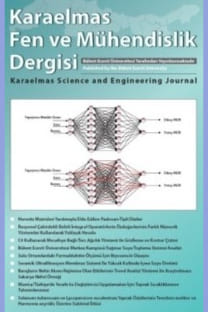Çorum İli Yeraltı Kömür Ocaklarında Radon Yoğunluğu Ölçümü
Bu çalışmada, Çorum ili bünyesinde faaliyet gösteren ve özel şirket tarafından işletilen 2 farklı ilçede ve 3 farklı yeraltı kömür ocağında radon yoğunluk ölçümleri yapılmıştır. Her bir madene 25 ile 30 arasında CR-39 radon detektörü madenlerin her bir farklı noktasına yerleştirilmiştir. Yerleştirilen bu detektörlerin ortalama 45 gün ile 60 gün arasında işleme tabi tutulmuştur. Belirlenen gün sonunda toplanan detektörler hava ile teması iyice kesilmesi için alüminyum folyo ile sarılarak izole edilmişlerdir. İzole edilen detektörler Çekmece Nükleer Araştırma Merkezinde ÇNAEM deneysel işlemlerden geçirilmiş ve Bq/m3 cinsinden radon yoğunlukları elde edilmiştir. Elde edilen radon yoğunlukları, Türkiye Atom Enerjisi Kurumu TAEK kurumu tarafından yeraltı maden ocakları için belirlenen 1000 Bq/m3etkin değerinin altındadır. Diğer taraftan, ölçülen bazı değerler Uluslararası Radyasyondan Korunma Komitesi ICRP tarafından yeraltı maden ocakları için tavsiye edilen 500-1500 Bq/m3 etkin değer aralığı içinde kalmaktadır
Anahtar Kelimeler:
Radon, CR-39 dedektörleri, Kömür ocakları, Çorum
Radon Concentration Measurement in the Underground Coal Mines of Çorum Province
In this study, the radon concentration measurements of three different underground coal mines that are run by a private company in two different towns of Çorum were carried out. About 25-30 pairs of CR-39 etch track detectors were placed to the different points of coal mines. These detectors were kept at these points for about 45-60 days. In order to prevent these detectors to contact with air, they were covered with foils. These detectors were carried to Çekmece Nuclear Research & Training Center ÇNRTC and proceed for experimental process and lastly radon concentrations were obtained as Bq/m3. The measured values of radon concentrations are under the action level 1000 Bq/m3 for underground coal mines recommended by Turkish Atomic Energy Agency TAEA . On the other hand, some of the measured values are in the range of the action levels 500-1500 Bq/m3 recommended by International Commission of Radiation Protection ICRP for underground coal mines.
Keywords:
Radon, CR-39 detectors, Coal fields, Çorum,
___
- Aytekin, H., Baldık, R., Çelebi, N. 2009. Radon Fluctuatıons in the Armutçuk Coal Mıne. Fresen. Environ. Bull. 18(1): 87-91.
- Baldık., R. 2005. Gökgöl ve Cehennemağzı Mağaraları ile Amasra Taşkomuru İşletmesi’nde Radon-222 Olcumu, Yuksek Lisans Tezi, Zonguldak Karaelmas Üniversitesi, Fen Bilimleri Enstitüsü, Zonguldak.
- Baldık, R., Aytekin, H., Ataksor, B., Tasdelen, M. 2006. Radon Concentration Measurements in the Amasra Coal Field. Radiat. Prot. Dosim., 118 (1): 122–125.
- Botkin, D., Keller, E. 1988. Environmental Science. John Wiley & Sons, NY.
- Fişne, A., Ökten, G., Çelebi, N. 2005. Radon concentration measurements in bituminous coal mines. Radiat. Prot. Dosim., 113 ( 2): 173-177.
- Hubbard, L., Swedjemark, GA. 1991. Radon dynamics in Swedish dwellings: a status report. In: Proceedings of International Symposium on Radon and Radon Reduction Technology, Philadelphia, vol. 3. US Environmental Protection Agency, Research Triangle Park, NC Paper V-4.
- International Commission on Radiation Protection (ICRP), 1987. Lung Cancer Risk from Indoor Exposure to Radon Daugthers. ICRP Publication. 17 (1): p. 50.
- International Commission on Radiation Protection (ICRP), 1993. Protection against 222Rn at home and work. ICRP Publication, 22 (2): p.65.
- ISSN: 2146-4987
- Yayın Aralığı: Yılda 2 Sayı
- Başlangıç: 2011
- Yayıncı: ZONGULDAK BÜLENT ECEVİT ÜNİVERSİTESİ
